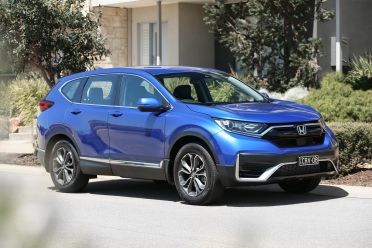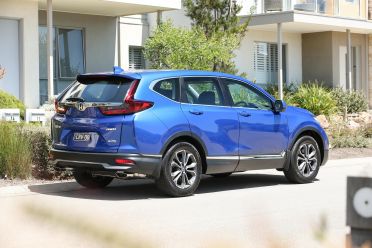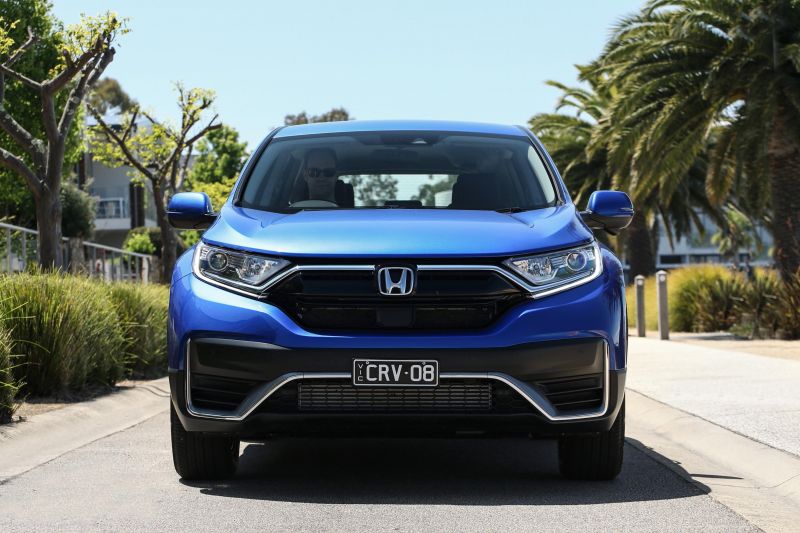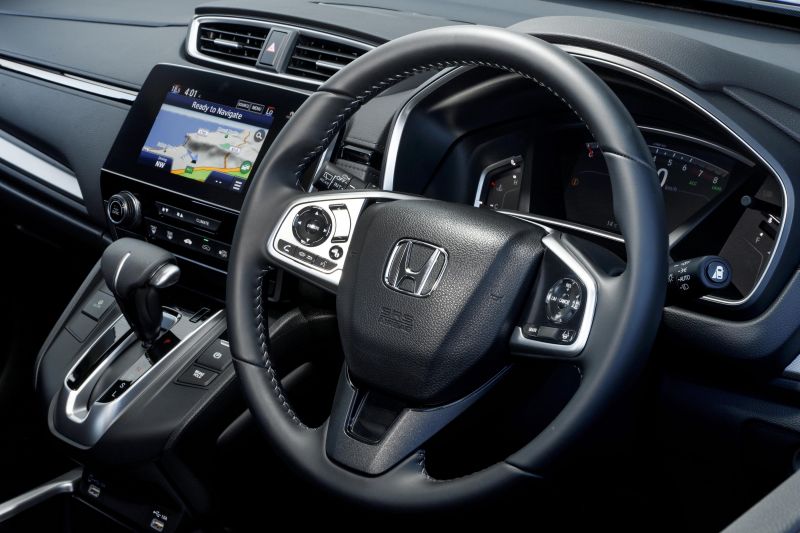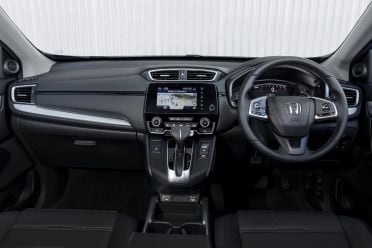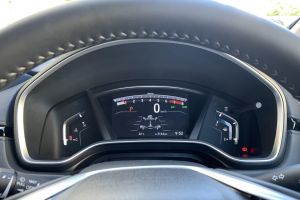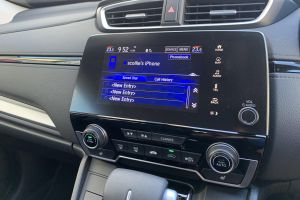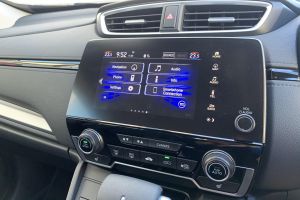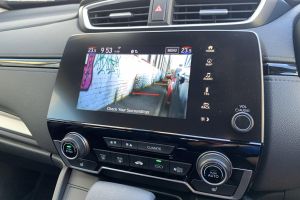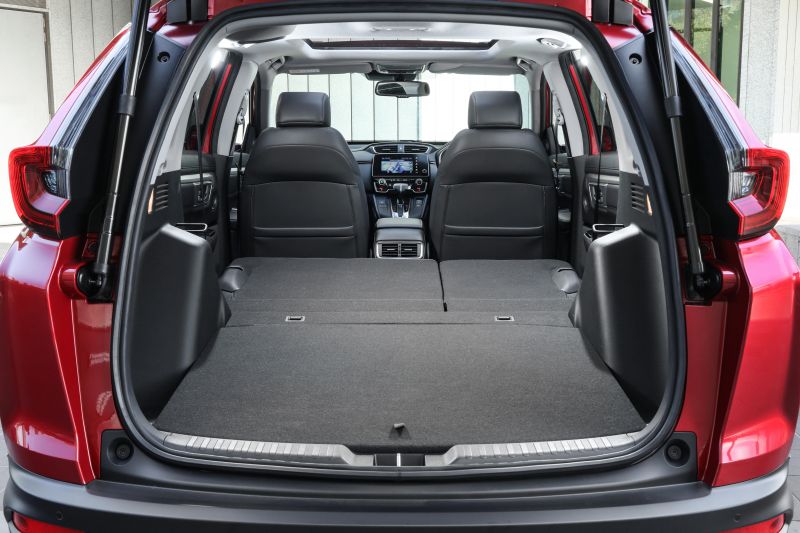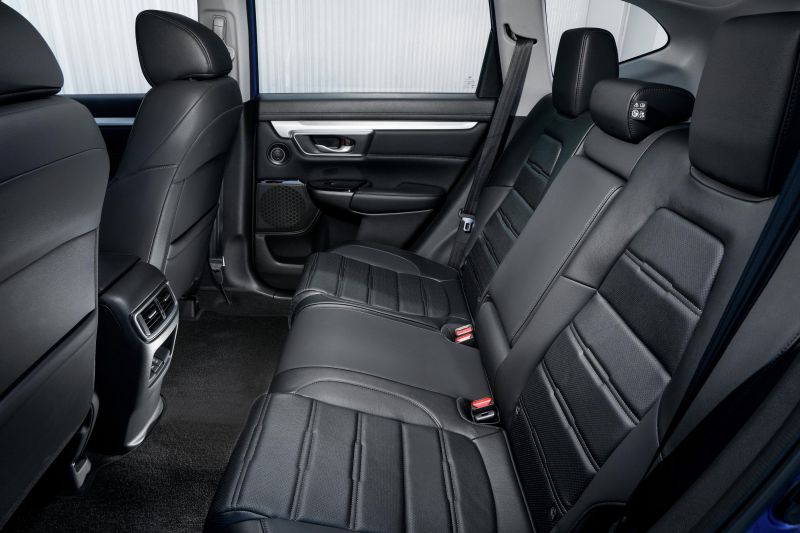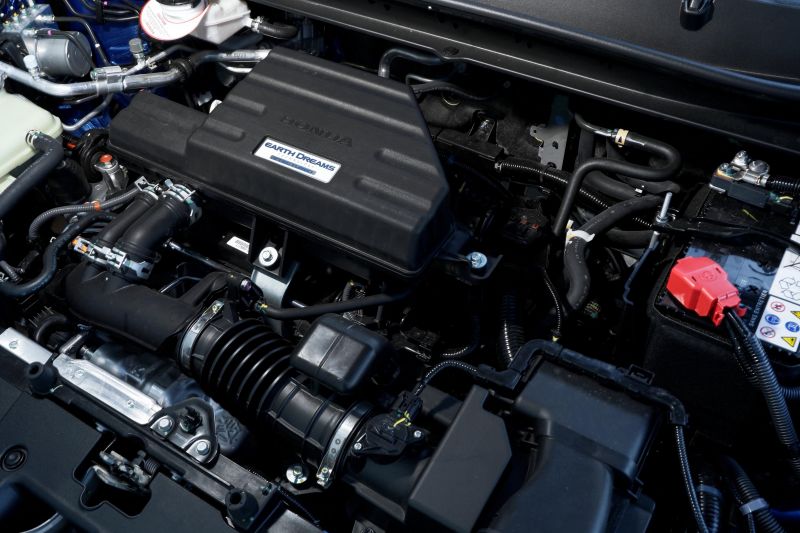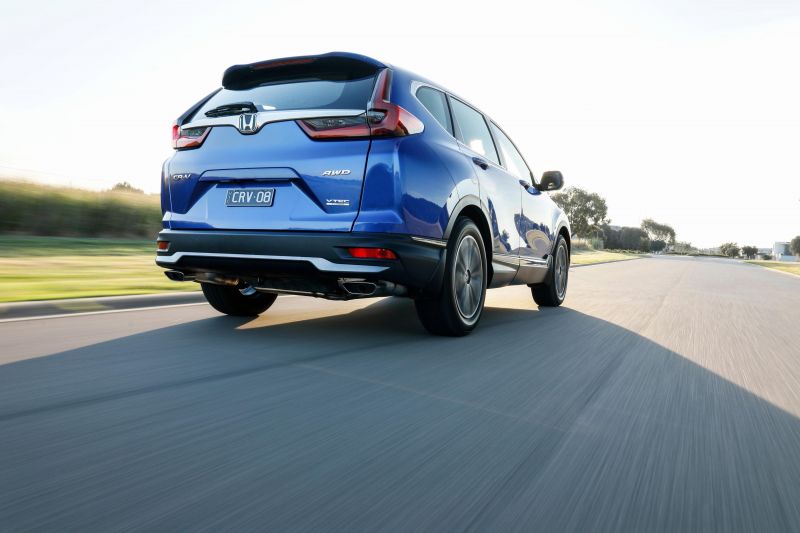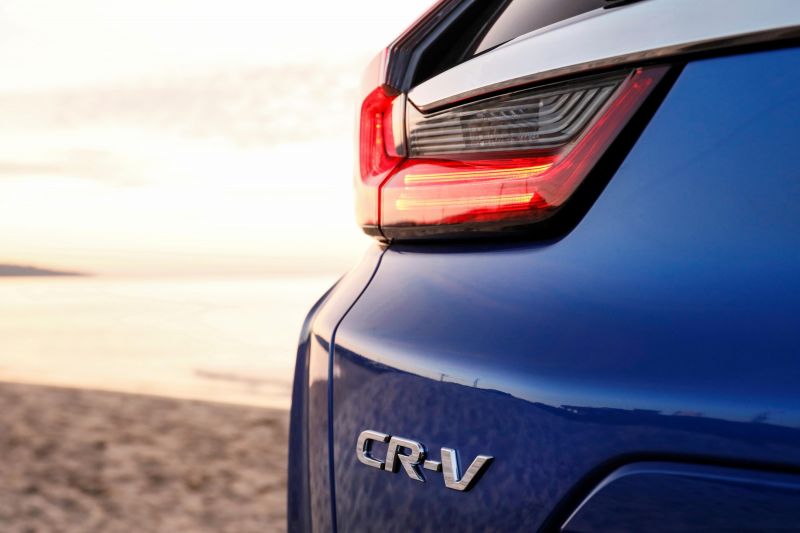Forget about Holden vs Ford, the battle for the hearts and driveways of middle Australia is playing out in the world of mid-sized SUVs.
Toyota RAV4 vs Mazda CX-5 or Honda CR-V vs Subaru Forester. Whatever your preference, keeping up with the Joneses is all about the crossover parked in front of your home among the gum trees (or your apartment among the apartments).
The Honda CR-V is one of the longest-running nameplates in the segment, having debuted in 1995. The current model burst onto the scene in 2017 with a bigger body, a turbocharged 1.5-litre engine, and a full suite of active safety features available at the top of the range.
Honda hasn’t messed with the formula too much for 2021. The CR-V range has been reshuffled to feature more standard kit, and there’s a slightly bolder new look and detail changes to the interior.
Then again, there’s wasn’t all that much that needed changing. The CR-V is the best-selling car in Honda’s Australian range, and is a key cog in its plan to slim down sales volume and transition to a centrally-managed sales model.
Is the updated VTi L AWD worthy of your attention in a segment chock full of quality cars?

How much does the Honda CR-V VTi-L AWD cost?
The VTi L AWD sits below the range-topping VTi LX AWD in the five-seat CR-V range, although they’re split on price by the front-wheel drive VTi L7.
It’s the cheapest way to get all-wheel drive in a CR-V, and comes with plenty of luxuries. But more on that in a moment.
Pricing for the updated CR-V range starts with the Vi at $30,490 before on-road costs, and extends to $47,490 before on-roads. The VTi L AWD on test sits right in the middle, with a starting price of $40,490 before on-roads.
Unusually, metallic and pearlescent paint is a no-cost option. There are seven colours available for 2021.
The VTi L AWD is priced head-to-head with the Toyota RAV4 GX AWD ($40,070 list), Mazda CX-5 Touring AWD ($40,980 list), Subaru Forester 2.5i Premium ($40,440 list), Hyundai Tucson Elite ($41,200 list), and the Ford Escape ST-Line AWD ($40,990 list).
It’s a crowded part of the new car market, as you can see.
What do you get?
Standard equipment across the CR-V range includes dual-zone climate control, a 7.0-inch infotainment system with Android Auto and Apple CarPlay, halogen headlights, a reversing camera, 17-inch alloy wheels, and a full-sized spare beneath the boot floor.
Moving through the range adds the Honda Sensing suite of driver aids including autonomous emergency braking, lane departure warning, lane-keeping assist, road departure mitigation, and adaptive cruise control.
There’s also auto walk-away door locking, keyless entry and start, a boot luggage cover, and four USB ports.
Like the VTi X below it in the range, the VTi L AWD has a hands-free power tailgate, 18-inch alloy wheels, automatic headlights and high-beam assist, a leather-trimmed steering wheel, camera-based blind-spot monitoring, parking sensors, and satellite navigation with traffic updates.
Unique to the VTi L AWD are leather seats with heating up front, and an eight-way powered driver’s seat – along with all-wheel drive, naturally.
There aren’t many notable exceptions from the VTi L AWD, but the package would be improved with the addition of the LED headlights and wireless phone charging from the VTi L7.
Along with their better performance at night, the LED headlights match the white daytime running lights in a way the yellow halogens can’t, while wireless charging is fast becoming a must-have for the convenience it offers.
Is the Honda CR-V safe?
The CR-V has a five-star safety rating from ANCAP, on the back of testing conducted in 2017.
It scored 14.76 out of 16 for the frontal offset test, 16 out of 16 for the side impact test, and two out of two for the pole test, for a total score of 35.76 out of 37.
Our VTi L AWD tester comes with a full suite of active safety assists, including autonomous emergency braking, lane departure warning, lane-keeping assist, road departure mitigation, and adaptive cruise control.
It also features the LaneWatch camera which, when you indicate left, projects an image from under the left-hand mirror on the infotainment display in place of a conventional blind-spot monitoring system.
Honda argues it’s less ambiguous than blind-spot monitoring indicators because it shows up to 50m behind the car and up to two lanes across, but it would still be improved by the addition of a conventional blind-spot light.
The ability to clearly make out cyclists and the complete picture it offers of your surroundings is undoubtedly a positive, but it can be tricky to make out cars at night, where headlights can dazzle the camera.
What is the Honda CR-V VTi L AWD like on the inside?
The CR-V majors on practicality and comfort. Given this is a family-focused SUV, those are both very good things.
The amount of storage up front is seriously impressive. A massive bin sits under the central armrest, covered by a rubber-lined sliding tray than can be moved forward to hide what’s inside, moved backwards for access, or removed entirely if that’s your style. There’s a 12V connector in there, too.
The transmission tunnel is home to two generous cupholders and another oddment storage tray under the dashboard, where the wireless charger has been fitted to higher-end models. It’s a good place to put your phone if it’s plugged into Apple CarPlay, but a wireless charger would have been better again.
There’s also big door pockets and a small, open cubby to the right of the steering wheel for a garage clicker.
Honda has nailed the seats in the CR-V. They’re attractive to look at, comfortable to sit in on long journeys, and have enough bolstering for harder cornering as well. The fact they’re heated is a bonus, too.
The leather-trimmed steering wheel is similarly excellent, with a chubby rim and logically laid-out buttons.
Facing the driver is a digital instrument display with a retro, horizontally-oriented rev counter, prominent digital speedo, and monochrome trip computer below it. Flanking it are two funky-looking gauges for engine temperature and fuel.
It’s clear and easy to read on the move, and throws back to Hondas of yore like the S2000 with its bar-style rev-counter – not that you’ll spend all that much time chasing the redline here.
If there’s a weak point it’s the infotainment system which, although functional, feels a bit dated. The in-house infotainment system is a huge step up on the aftermarket-looking setup from the smaller HR-V, but the graphics are basic and the responses slow compared to the latest from its rivals.
The best option to hook up smartphone mirroring for mapping, media, and phone calls. Although there are hard climate control buttons at the base of the display, some functions (such as air-conditioning on/off) are buried in a touchscreen menu, which requires more button pressing than is ideal.
For the most part it’s functional, but the technology lacks the polish evident elsewhere in the mid-sized SUV class.
Entry to the rear seats comes through 90-degree-opening doors that make loading children or bulky items a breeze. Legroom is very impressive, as is headroom for even lanky passengers. There are two USB ports on the back of the transmission tunnel, along with air vents.
The rear seats can also be slid back and forward or reclined/made more upright to free up more boot space, which is a nice touch.
With large windows and high-set rear seats, small children should have no trouble seeing out, and the cabin feels light and airy. It’s clear the CR-V was designed with families in mind. There are two ISOFIX and two top-tether mounts for child seats.
Boot space is 522L with the rear seats in place, expanding to 1084L with them folded. The boot floor is low for easy loading and the kick-operated powered tailgate is height-adjustable, if a little slow to operate.
What’s under the bonnet?
Although a naturally-aspirated 2.0-litre engine is available in the very base CR-V, the VTi L AWD comes standard with a 1.5-litre turbocharged four-cylinder petrol engine.
Peak power is 140kW at 5600rpm, and maximum torque is 240Nm between 2000rpm and 5000rpm.
The VTi L AWD is all-wheel drive, as the name suggests, and features a CVT automatic.
Honda claims it will use 7.4L/100km of regular unleaded fuel on the combined cycle, we saw between 8.5L/100km and 9.0L/100km in a mix of urban and highway driving.
Big wheels, big comfort
The Honda CR-V rides exceptionally well, especially given it's on 18-inch alloy wheels
How does the Honda CR-V VTi L AWD drive?
A small displacement engine and CVT doesn’t sound like a recipe for effortless performance, but the CR-V is actually a smooth, punchy thing to punt around town.
The transmission doesn’t flare or drone like some CVTs, instead just quickly escorting the engine into its torque sweet spot just above 2000rpm and keeping it there. There’s a hint of the rubber band feeling common with this type of transmission when you really punch the throttle from low speed, but it’s far from a deal-breaker.
Lean harder on the throttle and the revs climb slightly, but it’s very happy just sitting in the peak torque band and humming smoothly away. There’s hardly any engine noise in normal driving, and vibrations are kept in check from behind the wheel.
Driven calmly, the CR-V is just a very nice place to spend time. Although it’s not the most powerful or torquiest car in its class, it’s also more than capable of getting a move on at highway speeds.
The engine sits in its sweet spot at a cruise, and there’s plenty of punch for overtaking on country roads. Road noise is well suppressed at 100km/h, and there’s barely any wind whistle from the mirrors. It’s serene, provided the kids aren’t making noise in the back.
Ride quality is very impressive, especially when you consider the CR-V is riding on 18-inch wheels. It’s relaxed over small city-sized bumps and potholes, dispatching them with a minimum of fuss. Body control is also impressive.
There’s no wobbling or bobbing at higher speeds, the car just handles bumps, dips, and crests in one tight motion.
Steering is light and quick off-centre at low speeds, making city streets a breeze to navigate. With excellent sight lines and a tight turning circle there’s no excuse for scraped wheels, bumpers, or mirrors.
The steering also weights up nicely at speed for a planted feel on the highway. There’s even a bit of fun to be had tipping the CR-V into the corners, although it’s no Civic Type R on stilts.
How much does the Honda CR-V VTi L AWD cost to run?
Maintenance in the CR-V is required every 12 months or 10,000km – whichever comes first. The first 10 services each cost $312 under Honda’s capped-price service program.
The car is backed by a five-year, unlimited-kilometre warranty.
CarExpert’s take on the Honda CR-V VTi L AWD
Manic Civic Type R hot hatch aside, it’s easy to argue the CR-V is the best car in the Honda Australia line-up.
It drives like a class-leader, has the practicality to match it with the best, and is impressively appointed in VTi L trim. Although it’s not essential in city-bound crossovers, the fact it’s the most affordable all-wheel drive model in the CR-V range adds to the appeal.
It’s hard to argue you need the range-topping VTi LX AWD, given it’s $7000 more expensive and adds a lot of features that are nice to have but far from essential.
The CR-V absolutely deserves to be near the top of your shortlist, especially if outright practicality is your primary consideration.







